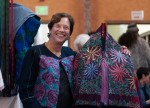Powell Library’s rotunda has traded in books for vibrant ponchos.
“When you come into Powell, you can’t miss it,” said Patricia Greenfield, a distinguished professor of psychology and the curator of “Weaving Generations Together,” an exhibit consisting of Maya weavings and embroideries.
Greenfield, who acquired the pieces during her trips to Nabenchauk, a hamlet in Chiapas, Mexico, worked with Powell Library staff and other team members to transport the exhibit’s pieces, which were originally displayed at the Maxwell Museum of Anthropology in Albuquerque, New Mexico, to Powell Library, where they will remain until Dec. 15.
Greenfield first visited Nabenchauk in 1969 with the Chiapas Project at Harvard University to research the Tzotzil-Maya cultures of Chiapas. Greenfield’s research in 1969 largely focused on culture and cognitive development, she said.
In Nabenchauk, Greenfield began collecting data on the design process of the cultures’ weavings by taking photographs of the different pieces she studied. She said she found the designs – which mostly consisted of solid colors and stripes – beautiful and began buying the textiles from the families for herself.
Greenfield said upon returning to Nabenchauk in 1991, she found the style of the weavings had changed dramatically: Instead of the solid colors and stripes, bright floral patterns had become dominant. She added she continued collecting the weavings and still receives them.
One Nabenchauk resident designed a deep purple blouse with bright flowers and leaves painted on it that Greenfield wore for the exhibit’s opening at the Maxwell Museum. The blouse is displayed in the front of the exhibit on clear plastic rods in the rotunda of Powell.
Greenfield said she wanted to bring the exhibit from Maxwell Museum to UCLA so more students could see the designs. She said she had to create adaptations of traditional museum materials, such as vertical glass cases, to make the exhibit work in Powell Library’s space.
Greenfield said the curtain rods worked well to display some of the ponchos because she could not put nails or screws into the bookshelves.
“I basically bought Bed Bath and Beyond out of their stock,” Greenfield said Thursday in a speech to the audience at the exhibit’s opening.
The Maxwell Museum sent clear plastic rods for the pieces displayed in the main rotunda, though they did not include any stands. Greenfield originally planned to solve the problem with Christmas tree stands, but after a friend told her the Christmas tree stands would not be strong enough, Greenfield bought all of the umbrella stands she could find at Orchard Supply Hardware.
“A lot of things (for which) we were like, ‘How are we going to do this,’ (Greenfield) brought out the most unusual way to do it, but it worked,” said Goldie Salimkhan, a UCLA alumna who worked with Greenfield on the graphic design and setup of the exhibit.
Greenfield also used lightweight mannequins she purchased from the Los Angeles Fashion District to display some of the weavings, which she said allowed the exhibit to be moved around for other Powell events.
“Trying to make the materials that we have here in the library work in the absence of official museum materials … you had to think about it,” said Brianna Vanden Bosch, a fourth-year art history student who assisted in setting up the exhibit.
Greenfield said she hopes Powell is a good location for students to be able to see the pieces in the exhibit – she plans on taking students in her Fiat Lux seminar and students in her course, Psychology 133G: “Culture and Human Development,” on guided tours of the exhibit throughout the quarter.
“I practically started to cry when I opened it because I had pieces in there that are so beautiful. … The actual thing is very emotional for me, and maybe they will be for the students as well,” Greenfield said.
